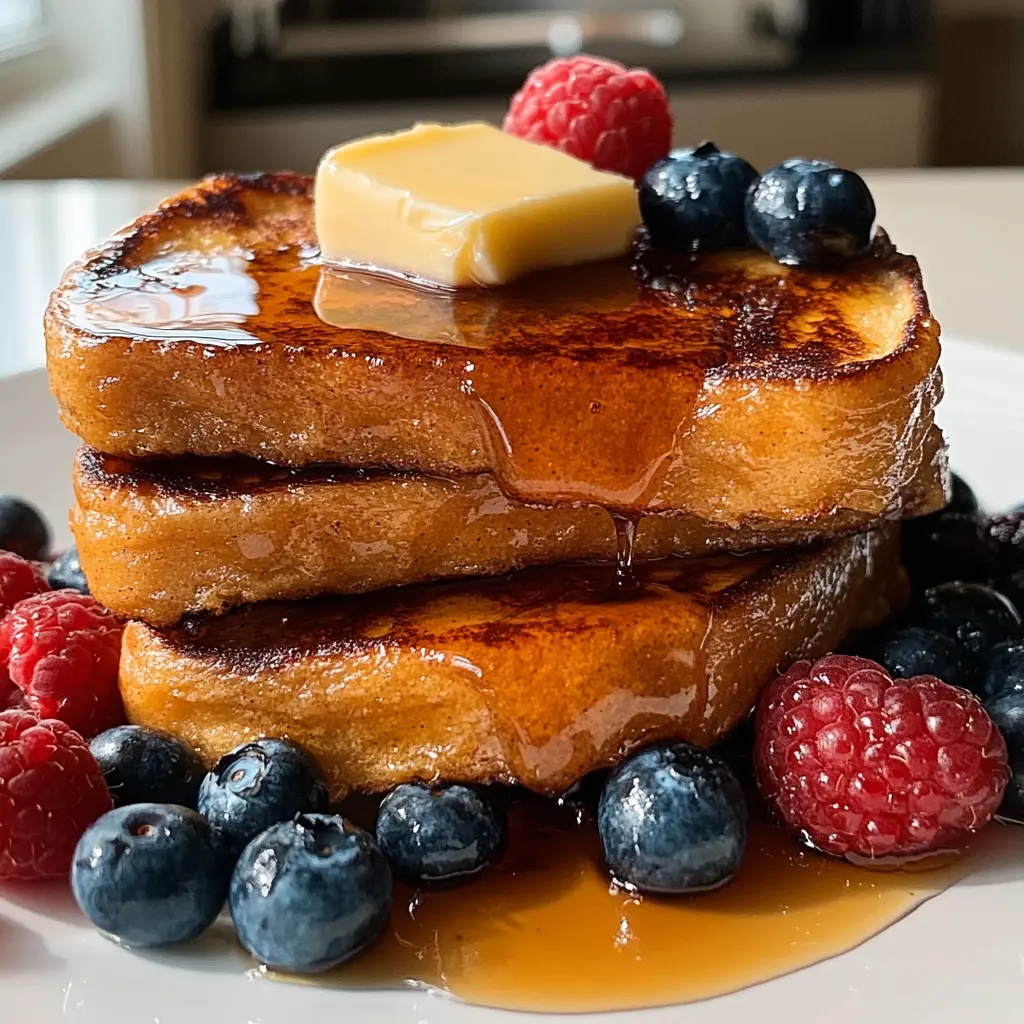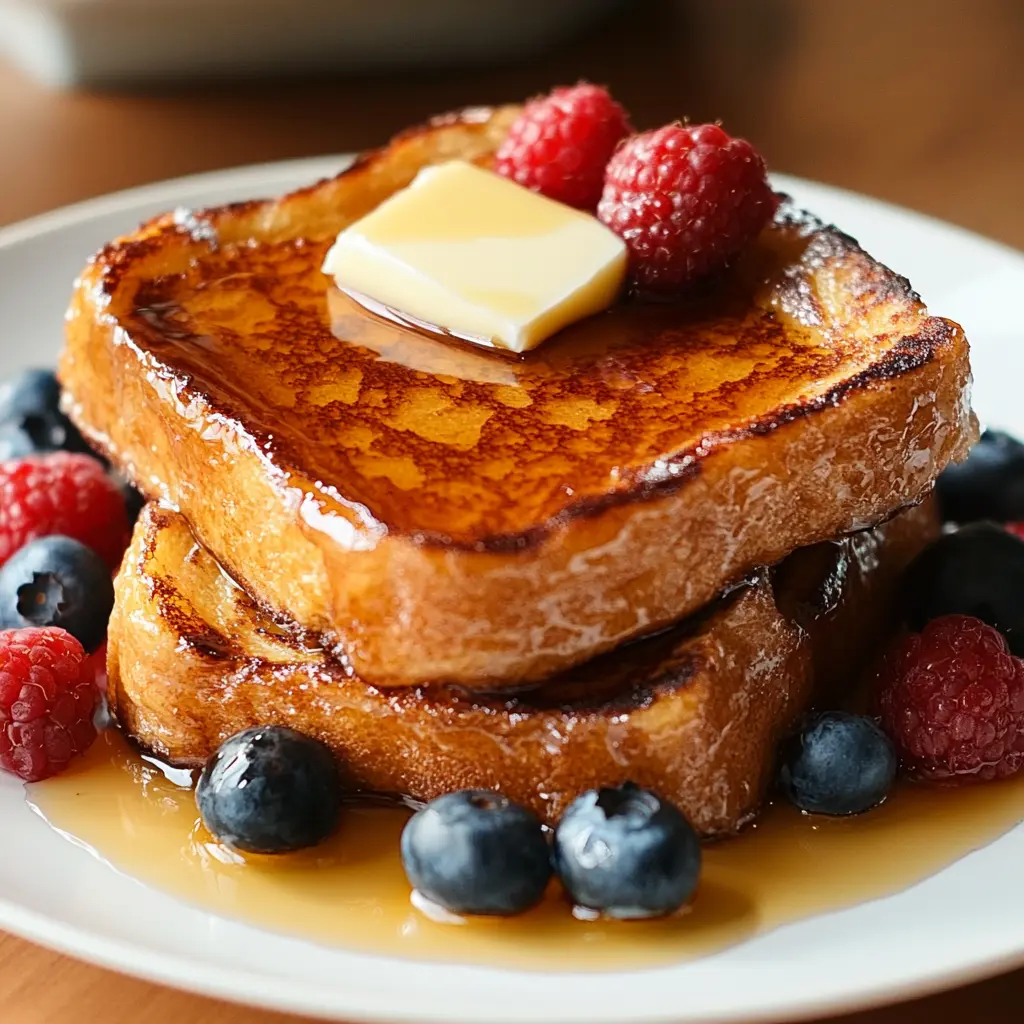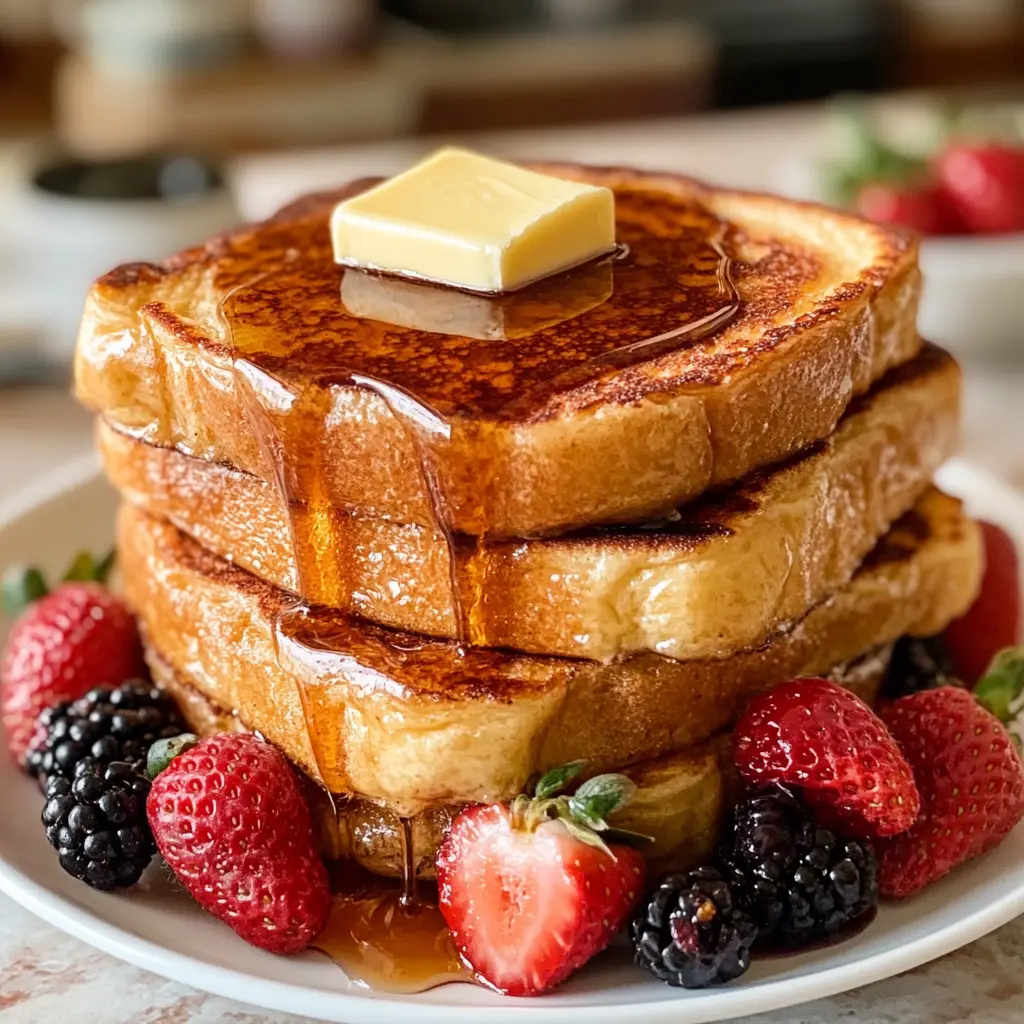Introduction
Introduction to Trick to Making Good French Toast
Trick to Making Good French Toast French toast: A beloved breakfast classic, is cherished for its rich, custardy interior and perfectly crisp exterior. The allure of this dish lies in its simplicity and the comfort it brings to the table. However, achieving the ideal French toast isn’t merely about following a recipe; it’s about understanding the nuances of technique and selecting the best ingredients. Whether you’re aiming for a traditional rendition or experimenting with creative variations, mastering the art of French toast can elevate your breakfast game to new heights.
In this guide, we will uncover the tricks to making good French toast. From choosing the right bread to perfecting the batter, cooking techniques, and enhancing flavors, you’ll find all the tips and secrets needed to create the perfect French toast every time.
Choosing the Right Bread for Trick to Making Good French Toast
Best Bread Types for French Toast
Brioche:
- Characteristics and Why It’s Ideal: Brioche is rich, buttery, and slightly sweet. Its tender crumb absorbs the egg mixture beautifully, resulting in a custardy interior with a crispy exterior.
Challah:
- Benefits and Flavor Profile: Challah has a light and airy texture, making it an excellent option. Its slight sweetness and soft crumb soak up the batter well, creating a delicate and flavorful French toast.
Sourdough:
- Unique Texture and Taste: Sourdough offers a unique tangy flavor and a firmer texture. This bread adds a delightful complexity to French toast, balancing sweetness with its distinctive taste and providing a slightly chewy bite.
Preparing the Bread
Slicing Thickness:
- Slice the bread about ¾ to 1 inch thick. This thickness ensures the bread absorbs the batter without becoming too soggy and holds up well during cooking.
Stale vs. Fresh Bread:
- Use slightly stale bread for best results. It absorbs the batter more effectively without falling apart. If you only have fresh bread, dry it out in the oven at a low temperature for a few minutes.
Perfecting the Batter
Essential Ingredients for French Toast Batter
Eggs and Milk Ratio:
- The basic ratio for a good batter is 1 egg per ¼ cup of milk. This balance provides the right consistency for a custardy texture. For a richer batter, use whole milk or a mix of milk and cream.
Adding Vanilla and Cinnamon:
- Vanilla extract and ground cinnamon are classic additions that enhance the flavor of the batter. Typically, use about 1 teaspoon of vanilla extract and ½ teaspoon of cinnamon per cup of milk.
Optional Additions
Nutmeg, Sugar, and Other Spices:
- A pinch of nutmeg adds warmth and depth to the batter. For a touch of sweetness, add 1-2 tablespoons of sugar or maple syrup.
Cream or Half-and-Half for Richness:
- For an even richer flavor, substitute part of the milk with cream or half-and-half. This creates a thicker, more luxurious batter.
Mixing Techniques
Achieving a Smooth Consistency:
- Whisk the eggs and milk thoroughly to ensure a smooth mixture without streaks of egg whites. This helps the bread soak up the batter evenly.
Tips for Even Flavor Distribution:
- First, mix the spices and flavorings into the milk to ensure they distribute evenly throughout the batter. This prevents clumps and ensures consistent flavor in every bite.
Cooking Techniques for Trick to Making Good French Toast
Prepping the Pan
Choosing the Right Pan or Griddle:
- A non-stick skillet or a well-seasoned cast-iron griddle works best for cooking French toast. These surfaces ensure even heating and prevent sticking.
Optimal Heat Settings:
- Preheat your pan over medium heat. If the heat is too high, the exterior will burn before the interior cooks. Medium heat allows the French toast to cook through evenly, achieving a golden brown crust without burning.
Cooking the French Toast
Soaking the Bread:
- Soak the bread slices in the batter for about 20-30 seconds per side. Ensure the bread is fully saturated but not falling apart. This step is crucial for a custardy interior.
Achieving the Perfect Golden Brown Crust:
- Melt butter or add a small amount of oil to the preheated pan. Place the soaked bread slices in the pan and cook for about 2-3 minutes per side, or until golden brown. Adjust the heat as necessary to avoid burning.
Avoiding Sogginess:
- Cook the French toast in batches, and avoid overcrowding the pan. This ensures each piece has enough space to cook evenly and develop a crispy crust. Place cooked slices on a wire rack to keep them from getting soggy while you finish cooking the rest.
Enhancing Flavor
Using Flavored Butters
How to Make and Use Them:
- Flavored butters can add an extra layer of flavor to your French toast. Mix softened butter with ingredients like honey, cinnamon, vanilla, or herbs. Spread the flavored butter on the hot French toast just before serving for a delicious finish.
Popular Flavors:
- Honey cinnamon butter, vanilla bean butter, and herb-infused butter (such as rosemary or thyme) are all excellent choices. These butters melt into the toast, adding richness and depth of flavor.

Adding Fillings
Stuffed French Toast Ideas:
- Create stuffed French toast by adding fillings between two slices of bread before soaking them in the batter. Popular fillings include cream cheese and fruit, Nutella and banana, or peanut butter and jelly.
Techniques for Adding Fillings:
- Spread the filling evenly on one slice of bread, then top with another slice to create a sandwich. Dip the sandwich in the batter, ensuring it absorbs the mixture, and cook as usual. This method results in a delicious, gooey center surrounded by crispy French toast.
Toppings and Garnishes
Fresh Fruit, Syrups, and Nuts:
- Top your French toast with fresh fruit like berries, sliced bananas, or apple compote. Drizzle with maple syrup, honey, or fruit syrups. Add a sprinkle of nuts for crunch, such as almonds, walnuts, or pecans.
Creative Topping Ideas:
- Consider toppings like whipped cream, yogurt, granola, or even a scoop of ice cream for a decadent treat. Savory toppings like bacon, sautéed mushrooms, or avocado also pair well with French toast, offering a delightful contrast to the sweet batter.
Serving Suggestions
Pairing with Sides
Sweet and Savory Options:
- Balance your meal with a mix of sweet and savory sides. Fresh fruit, yogurt, or a light salad can complement the richness of the French toast. Savory sides like bacon, sausage, or roasted vegetables add a nice contrast and make the meal more complete. For more ideas, check out what to serve with French toast.
Balancing Flavors and Textures:
- Consider the overall flavor and texture profile of your meal. Pair the creamy, custardy French toast with crunchy nuts or crispy bacon. Fresh fruit adds a refreshing element, while syrups and compotes enhance the sweetness.
Beverage Pairings
Coffee, Tea, and Juice Recommendations:
- A strong cup of coffee or a smooth latte pairs wonderfully with French toast. For tea lovers, consider black teas like Earl Grey or herbal teas like chamomile. Freshly squeezed orange juice or a fruit smoothie also make excellent pairings. Learn more about beverage pairings for French toast.
Matching Flavors:
- Match the flavor profile of your beverage with the French toast. For sweet French toast, pair with a lightly sweetened coffee or a fruity tea. For savory French toast, opt for a robust coffee or a herbal tea with earthy notes.
Tips and Tricks for the Perfect French Toast
Common Mistakes to Avoid
Over-Soaking the Bread: One common mistake is over-soaking the bread. While it’s essential to ensure the bread absorbs the batter, letting it sit too long can make it soggy and prone to falling apart. To avoid this, dip the bread slices in the batter for just 20-30 seconds per side. The bread should be fully coated but not drenched. This ensures a custardy interior without compromising the texture.
Using the Wrong Type of Bread: Not all breads are suitable for French toast. Thin, flimsy slices can disintegrate, while very dense breads might not absorb the batter well. Instead, opt for sturdy, slightly stale bread such as brioche, challah, or sourdough. These types of bread can hold up to soaking and cooking, providing the perfect texture and flavor.
Cooking at the Wrong Temperature: The temperature at which you cook your French toast is crucial. Cooking on too high a heat can burn the exterior while leaving the interior undercooked. Conversely, cooking on too low a heat can result in soggy toast. Aim for medium heat, which allows the French toast to cook through evenly, developing a golden-brown crust without burning.
Skipping the Preheat Step: Always preheat your pan or griddle before adding the French toast. A properly preheated surface ensures even cooking and helps to form a beautiful crust. Place the bread slices in the pan only when the butter or oil is hot and bubbly. This prevents sticking and ensures the toast cooks evenly.
Neglecting to Whisk the Batter Thoroughly: Whisking the batter thoroughly is essential for ensuring even flavor distribution and a smooth consistency. Any streaks of egg white or yolk can lead to uneven cooking and an inconsistent texture. Use a whisk to combine the eggs, milk, and spices until completely smooth.
Advanced Techniques for Trick to Making Good French Toast
Using a Double-Dip Method:
For an extra flavor boost, try the double-dip method. First, dip the bread in the batter and let it soak for a few seconds. Then, remove it and let it rest for a minute or two before dipping it again. This method allows the bread to absorb more batter, resulting in a richer, more flavorful French toast.
Caramelizing the Edges:
To add a delightful crunch and extra flavor, sprinkle a bit of sugar on the edges of the soaked bread just before cooking. As the French toast cooks, the sugar will caramelize, creating a sweet, crispy crust. This technique works particularly well with thick slices of brioche or challah.
Infusing the Batter:
For a unique twist, infuse your batter with different flavors. Try steeping a vanilla bean or cinnamon stick in the milk before mixing it with the eggs. This adds a depth of flavor that powdered spices can’t achieve. Strain the milk before combining it with the eggs to remove any solid pieces.
Baking Instead of Frying:
If you’re preparing French toast for a crowd, consider baking it instead of frying. Arrange the soaked bread slices on a baking sheet lined with parchment paper. Bake at 375°F (190°C) for about 15-20 minutes, flipping halfway through. This method ensures even cooking and frees up your stovetop for other dishes.
Making Stuffed French Toast:
Stuffed French toast adds an extra layer of decadence. Spread your desired filling (like cream cheese and jam or Nutella and banana) between two slices of bread before dipping them in the batter. Cook as usual, ensuring the filling is heated through and the exterior is golden brown.
Using a Sandwich Press:
For perfectly cooked, evenly pressed French toast, use a sandwich press or panini maker. The press applies even heat and pressure, ensuring the toast cooks quickly and evenly. This method is especially useful for stuffed French toast, as it keeps the filling contained and the bread crispy.
Making French Toast Ahead
Tips for Preparing in Advance:
so Trick to Making Good French Toast, French toast can be made ahead and frozen for convenient breakfasts or dinners. Cook the French toast as usual, then let it cool completely. Arrange the slices in a single layer on a baking sheet and freeze until solid. Once frozen, transfer the slices to a freezer-safe bag or container.
Best Methods for Reheating:
To reheat frozen French toast, use an oven or toaster oven to maintain the crispy texture. Preheat the oven to 350°F (175°C) and place the slices on a baking sheet. Heat for about 10-15 minutes, flipping halfway through. This method ensures the French toast is heated evenly and retains its crispy exterior.
Microwaving Tips:
While not ideal, you can microwave French toast if you’re in a hurry. Place a damp paper towel over the slices to retain moisture and prevent them from becoming rubbery. Heat on medium power for 1-2 minutes, checking frequently to avoid overcooking.
Storing Leftovers:
Store leftover French toast in an airtight container in the refrigerator for up to three days. To reheat, use a skillet over medium heat or a toaster oven to regain some of the original crispness. Avoid microwaving leftovers as it can make the toast soggy.
Making French Toast Casserole:
For a make-ahead option that’s perfect for gatherings, try a French toast casserole. Cube your bread and layer it in a baking dish. Pour the egg mixture over the bread, ensuring it’s well-coated. Cover and refrigerate overnight. In the morning, bake at 350°F (175°C) for 45-50 minutes until golden and set.
Preparing Individual Portions:
If you prefer, prepare individual portions of French toast in muffin tins. Cut the bread into smaller pieces and mix with the batter. Pour into greased muffin tins and bake at 350°F (175°C) for 20-25 minutes. These individual portions are easy to serve and reheat.
Customizing and Trick to Making Good French Toast
Using Different Types of Milk:
Experiment with different types of milk to change the flavor and texture of your French toast. Almond milk, coconut milk, or oat milk can add a unique taste and are great alternatives for those with dietary restrictions.
Incorporating Spices and Extracts:
Don’t limit yourself to just cinnamon and vanilla. Try adding almond extract, orange zest, or even a splash of rum or brandy to your batter. These additions can elevate the flavor profile and make your French toast stand out.
Adjusting Sweetness:
Control the sweetness of your French toast by adjusting the sugar in the batter. If you prefer a less sweet breakfast, reduce or omit the sugar and rely on toppings like fresh fruit or a light drizzle of honey for sweetness.
Adding Crunch with Coatings:
For an added crunch, coat the soaked bread slices with crushed nuts, cornflakes, or even panko breadcrumbs before cooking. This extra step adds texture and a delightful contrast to the soft interior.
Making Savory French Toast:
For a savory twist, skip the sugar and vanilla in the batter. Instead, add salt, pepper, and herbs like thyme or rosemary. Top with sautéed vegetables, cheese, and a fried egg for a hearty meal.
Creating Flavored Syrups:
Enhance your French toast with homemade flavored syrups. Simmer berries, citrus peel, or spices with maple syrup to create a custom topping that complements your dish perfectly.
By following these tips and techniques, you can elevate your French toast game and impress family and friends with delicious, perfectly cooked French toast every time. Whether you stick to the classics or venture into creative variations, the key to great French toast lies in the details. Enjoy experimenting and finding your perfect recipe!

Conclusion
Mastering the trick to making good French toast involves choosing the right bread, perfecting the batter, and using proper cooking techniques. Avoid common mistakes, and don’t hesitate to experiment with flavors and toppings. By paying attention to these details, you can create delicious, perfectly cooked French toast every time. Enjoy the process and have fun discovering your own favorite variations. Whether for breakfast, brunch, or even dinner, perfect French toast is always a delightful treat.
FAQs about Making Good French Toast
How do you keep French toast from getting soggy?
- Use thick, slightly stale bread and avoid over-soaking. Additionally, cook over medium heat to ensure a crisp exterior and custardy interior.
What is the best bread for French toast?
- Brioche, challah, and sourdough are the best options due to their texture and flavor. They absorb the batter well and hold up during cooking.
Can you make French toast without milk?
- Yes, you can use alternatives like almond milk, coconut milk, or even orange juice for a different flavor profile.
How do you add extra flavor to French toast?
- Add spices like cinnamon, nutmeg, or extracts such as vanilla or almond. Infusing the batter with these flavors can elevate your dish.
Is it better to use butter or oil for cooking French toast?
- Butter adds a rich flavor, while oil can provide a higher smoke point to prevent burning. Often, a combination of both works best.



